Mozart‘s birth was nothing short of miraculous, a moment that would go on to change the world of music forever. Born on 27 January 1756 in the heart of Salzburg, Austria, he arrived into a family already steeped in musical tradition. His father, Leopold, a composer and violinist, immediately recognised his son’s prodigious talent, and before long, young Wolfgang Amadeus was dazzling everyone around him with his unparalleled musical genius. From the very start, it was clear that Mozart wasn’t just a child prodigy; he was a once-in-a-lifetime musical force destined to push the boundaries of classical music to new heights.
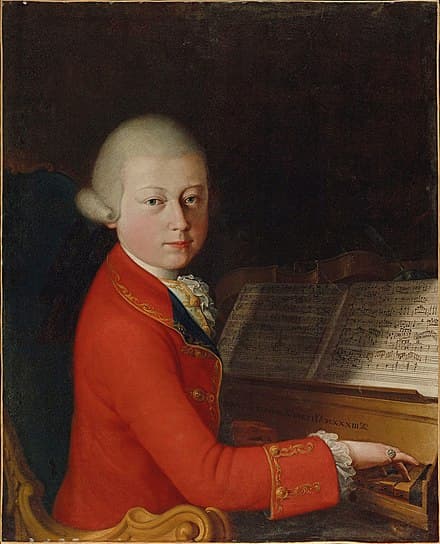
Portrait of Wolfgang Amadeus Mozart at the age of 13 in Verona, 1770
As we celebrate Mozart’s birthday on 27 January, we decided to showcase masterpieces of a very special kind. And I am talking about his church sonatas, sometimes also known as the “Epistle Sonatas.” Mozart wrote 17 of these short works, musical gems of concentration on the small form. As the composer himself said, “you need a special kind of training for this kind of composition.”
Wolfgang Amadeus Mozart: Church Sonata No. 14 in C Major, K. 278
Forgotten Gems
Don’t feel bad if you are not familiar with these charming miniatures. These works were part of the religious service at the cathedral in Salzburg, written for a very specific function. Today, they no longer have that particular function in the liturgy of the Catholic mass, and they certainly have no fixed place in the concert repertoire. The church sonatas by Mozart have led a life in the shadow; it’s high time to bring them into the light!
Wolfgang Amadeus Mozart: Church Sonata No. 5 in F Major, K. 145 (Vienna Academy Orchestra; Martin Haselböck, organ/cond.)
Official Church Musician
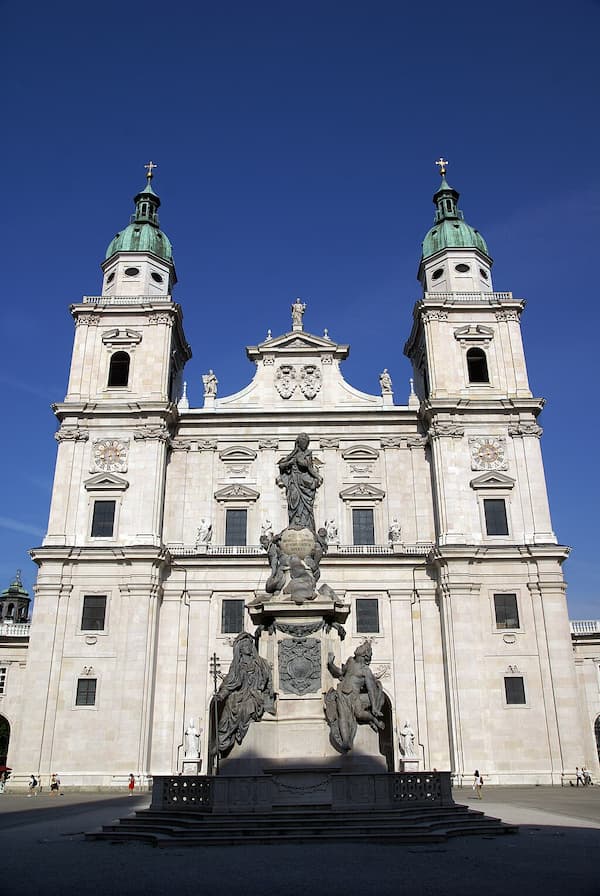
Salzburg Cathedral
The church sonatas date from a time when Mozart served at the court in Salzburg in an official capacity for 10 years. Initially he was hired as an unsalaried “concert master “on 27 October 1769, but was officially on the payroll in this particular position from August 1772 to August 1777. He was then promoted to “cathedral and court organist,” with a salary of 450 guilders in January 1779. This position would be terminated by the famous “swift kick to the backside” in May 1781.
Wolfgang Amadeus Mozart: Church Sonata No. 1 in E-flat Major, K. 67 “Epistle Sonata” (Johan Kracht, violin; Henk Rubingh, violin; Wim Straesser, cello; Brian Pollard, bassoon; Margaret Urquhart, double bass; Peter Hurford, organ)
Archbishop Colloredo
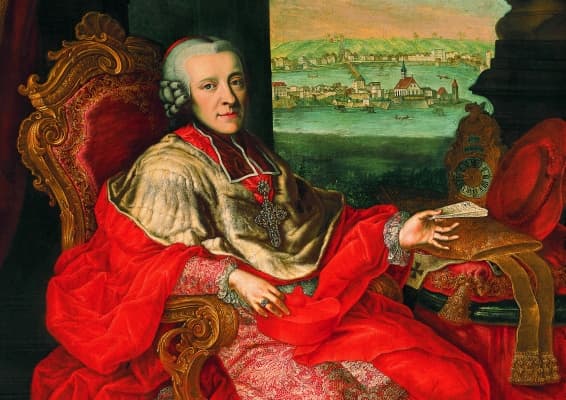
Archbishop Hieronymus Colloredo
Mozart had a famously turbulent relationship with his boss, Archbishop Hieronymus Colloredo. Colloredo was in charge for much of the 1770s and early 1780s, but their dynamic was strained from the start. Mozart, known for his independent spirit and desire for creative freedom, was at odds with the archbishop, who was more interested in maintaining control and adhering to formalities. The tension escalated as Mozart resented the rigid, often patronising treatment he received, especially when Colloredo limited his opportunities to compose freely and perform outside Salzburg.
Wolfgang Amadeus Mozart: Church Sonata No. 12 in C Major, K. 263 (Louis-Noël Bestion de Camboulas, organ, cond.; Les Surprises Ensemble)
Liturgical Function
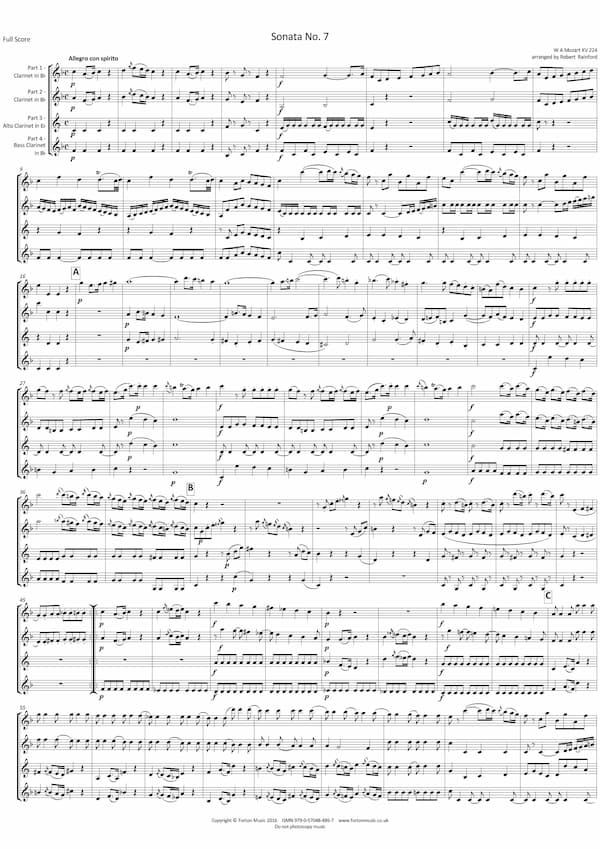
Mozart’s Church Sonata No. 7 in F Major, K. 224 music score excerpt
So, what was the specific liturgical function of Mozart’s church sonatas? We get the answer from a Mozart letter to Padre Martini from September 1776. Mozart wrote in Italian, “our church music is very different from that of Italy, since a mass with the whole Kyrie, the Gloria, the Credo, the Epistle Sonata, the Offertory or Motet, the Sanctus and the Agnus Dei, even the most solemn one, may not last more than a maximum of three-quarters of an hour when the Prince attends it; and yet it must be a mass with all instruments, war trumpets and timpani.”
Wolfgang Amadeus Mozart: Church Sonata No. 7 in F Major, K. 224 (Genevieve Soly, organ; I Musici di Montreal; Yuli Turovsky, cond.)
Epistle Sonata
From Mozart’s letter, we learn about the position of the “Epistle Sonata” in the liturgy, but it’s still not straightforward. One scholar wrote the following explanatory footnote to Mozart’s letter. “While the priest reads the Epistle, the organist played softly a sonata with or without violin accompaniment.” We do know that this type of musical composition probably originated in northern Italian churches in the 17th century and subsequently made their way into Austria.
Wolfgang Amadeus Mozart: Church Sonata No. 10 in F Major, K. 244 (Louis-Noël Bestion de Camboulas, organ, cond.; Les Surprises Ensemble)
Solemn Occasion
I can’t believe that Archbishop Colloredo would have tolerated any kind of music to interrupt the reading of the Epistle. It is much more likely that these short instrumental works sounded between the reading of the Epistle and the Gospel as the priest solemnly walked from the southern part of the church to the Nave.
Wolfgang Amadeus Mozart: Church Sonata No. 8 in A Major, K. 225 (Vienna Academy Orchestra; Martin Haselböck, organ/cond.)
Musician Placement
Now that we know when the Epistle Sonatas would have been performed within the liturgy, we still don’t know where the musicians would have been placed inside the church. Presumably, the position would have been close to the various organs in the Salzburg Cathedral, and we are fortunate to have an exact account of the number and dispositions of the organs from Leopold Mozart.
Wolfgang Amadeus Mozart: Church Sonata No. 15 in C Major, K. 328 (Johan Kracht, violin; Henk Rubingh, violin; Wim Straesser, cello; Margaret Urquhart, double bass; Brian Pollard, bassoon; Peter Hurford, organ)
Organs of the Cathedral
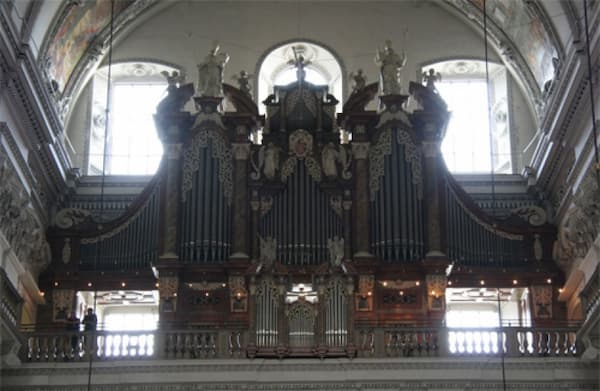
Salzburg Cathedral main organ
Leopold writes, “In the Archiepiscopal Cathedral, the large organ is placed at the back near the entrance of the church; nearer the front, at the choir, there are four auxiliary organs, and below, in the choir itself, there is a small choir-organ about with the singers are placed. During an elaborate service, the large organ is used only for playing the prelude; for the remainder of the service, however, one of the four auxiliary organs is constantly employed, particularly the one nearest the right side of the altar, where the solo singers and basses are stationed.”
Wolfgang Amadeus Mozart: Church Sonata No. 4 in D Major, K. 144 (Johan Kracht, violin; Henk Rubingh, violin; Wim Straesser, cello; Margaret Urquhart, double bass; Brian Pollard, bassoon; Peter Hurford, organ)
Large Forces
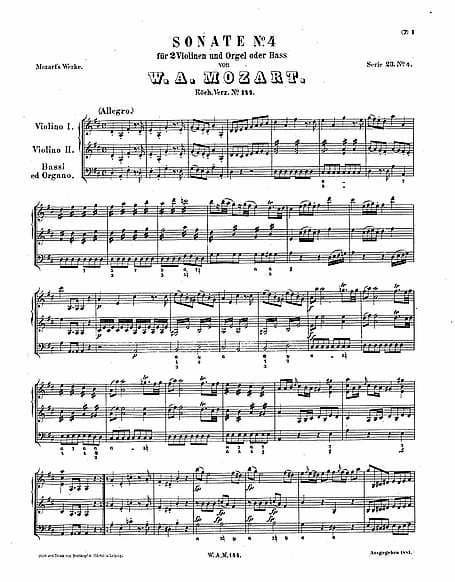
Mozart’s Church Sonata No. 4 in D Major, K. 144 music score excerpt
Leopold continues, “opposite, at the left auxiliary organ, are the violinists, etc., and the two groups of trumpets and kettledrums are near the remaining auxiliary organs. The lower choir organ and violins join in at fully scored passages. The oboes and flutes are seldom heard in the Cathedral, and the horn never. All these players are able to play violins if necessary. The full number of persons connected with music, or who receive pay for musical service at the court, is ninety-nine.”
Wolfgang Amadeus Mozart: Church Sonata No. 6 in B-flat Major, K. 212 (Budapest Ferenc Erkel Chamber Orchestra; János Sebestyén, organ)
Mozart the Organist
Since every epistle sonata features the organ in one way or another, maybe we also have to look at Mozart’s relationship with that instrument. He held an immense appreciation for the organ, and in a letter to his father in 1777, he wrote, “In my eyes and ears, the organ is the king of instruments.” However, Mozart composed virtually no works for the organ, aside from a few fugues or fragments of fugues.
Wolfgang Amadeus Mozart: Church Sonata No. 13 in G Major, K. 274 (Thomas Fheodoroff, violin; Regine Schroder, violin; Alexandra Dienz, double bass; Martin Haselböck, cond.)
Mozart the Improvisor
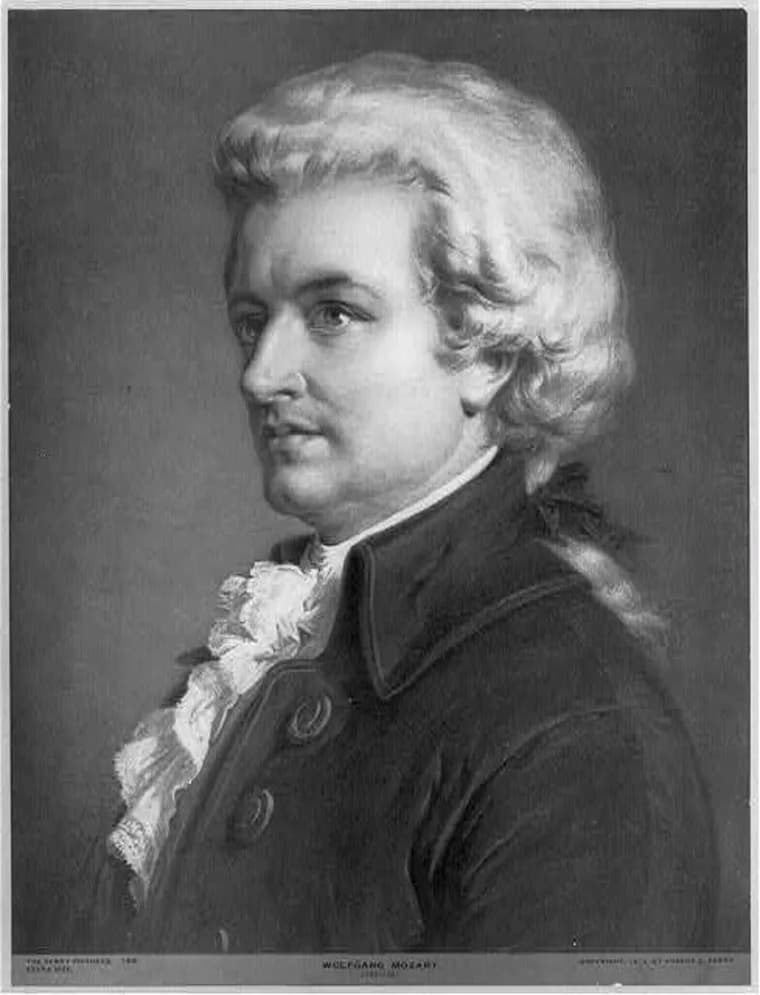
Wolfgang Amadeus Mozart © media-cldnry.s-nbcnews.com
However, when it came to playing the organ, Mozart was an undisputed master. The composer Carl Czerny reported that Mozart was able to play the organ with great virtuosity and could improvise intricate music on the spot. That impression is confirmed by Johann Friedrich Doles, Kantor of St. Thomas Church in Leipzig. After hearing Mozart improvise, he wrote, “I was enchanted by his playing and thought that my teacher, old Sebastian Bach, had been reborn.”
Wolfgang Amadeus Mozart: Church Sonata No. 2 in B-flat Major, K. 68 (Ensemble Les Surprises; Louis-Noël Bestion de Camboulas, organ/cond.)
The 17 Church Sonatas
Mozart composed a total of 17 Church Sonatas during his tenure at Salzburg Cathedral. They correspond, as Martin Haselböck has observed, with the seventeen instrumental masses composed by Mozart. Scored predominantly for strings and organ, which function either as a solo instrument or as continuo, these works display Mozart’s genius for melody, form, and instrumentation. The first three sonatas, K. 67-69 were possibly written when Mozart was only about eleven years old.
Wolfgang Amadeus Mozart: Church Sonata No. 11 in D Major, K. 245 (Budapest Ferenc Erkel Chamber Orchestra; János Sebestyén, organ)
Early Efforts
The actual date of Mozart’s earliest church sonatas is uncertain, but together with K. 144 and 145, they were probably written in the first year of Mozart’s appointment at the cathedral. As you can tell, they are really very short and probably exactly what the Archbishop wanted. As a general observation, the 17 Sonatas are written in 7 keys. Although they are all in major, Mozart does include some striking modulations into the minor key. In Mozart’s hand, as we well know, two bars of minor harmonies can say more than an entire symphony elsewhere.
Wolfgang Amadeus Mozart: Church Sonata No. 9 in G Major, K. 241 (Johan Kracht, violin; Henk Rubingh, violin; Wim Straesser, cello; Margaret Urquhart, double bass; Brian Pollard, bassoon; Peter Hurford, organ)
Central Group
The sonatas in the group ranging from K. 212 to K. 278 originate between 1775 and 1777 and were written for the same ensemble as the first five, for two violins, cello, organ, and bass. There are only two exceptions, K. 263 added a pair of trumpets, and K. 278 featured trumpets, timpani, and a pair of oboes as it was a festive piece written for Easter Sunday in 1777.
Wolfgang Amadeus Mozart: Church Sonata No. 16 in C Major, K. 329 (Budapest Ferenc Erkel Chamber Orchestra; János Sebestyén, organ)
Delicious Variety
Let us briefly look at two specific examples, first the sonata K. 244, dating from April 1776. Delicately structured and emphasising a light musical texture, this Sonata opens with a stately and invigorating yet charming musical theme. Independently contributing to the musical discourse, the organ plays a separate concertante part, clearly audible in the slightly subdued thematic contrast.
Composed in 1777, the sonata K. 274 begins with a sprightly unison passage that quickly gives way to an energetic theme. A subtle modulation gradually directs the music towards a delicate dialogue between the instruments before the opening section is repeated.
Wolfgang Amadeus Mozart: Church Sonata No. 3 in F Major, K. 69 (Genevieve Soly, organ; I Musici di Montreal; Yuli Turovsky, cond.)
Final Efforts
The last three church sonatas, K. 328, 329, and 336, have a much more important organ part. Since Mozart would have been playing the organ, he made sure that he would have something interesting to do. K. 328 immediately displays a festive character, one that is not necessarily bound to its sacred function. Operatic in character and symphonic in its overall formal and musical structure, the independent organ part once more enriches the musical texture and provides colourful timbral contrasts.
In fact, K. 336 follows the character and convention of an instrumental concerto. Introduced in the strings, the thematic material is immediately taken over by the organ and thoroughly embellished. This miniature concerto even includes a dedicated cadenza, in which the organist performs an elaborate and virtuosic improvisation.
Stylistically, the works written during the course of one decade mirror the rapid development of Mozart the composer. While the spirit of the Italian opera pervades the early compositions, “the polyphonic structure is increasingly interrupted in favour of a symphonic development.” The great movements “correspond to the symphonic and concertante pieces written around the same time in both their construction and thematic work.”
As Gerald Larner writes, “Mozart gradually asserted his authority from K. 224 onwards, enriching both the texture and the construction, adding harmonic and colour interest, and finally achieved mastery of a peculiar Salzburg form by expanding its limitation.” I am pretty sure that Mozart managed to irritate the impatient Archbishop! While these sonatas are not as widely known as some of Mozart’s other works, they are certainly impressive in their depth and spiritual expressiveness. Happy Birthday!
For more of the best in classical music, sign up for our E-Newsletter
Wolfgang Amadeus Mozart: Church Sonata No. 17 in C Major, K. 336 (Vienna Academy Orchestra; Martin Haselböck, organ/cond.)

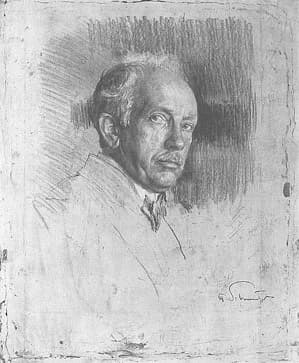
Thank you for this very informative article together with the selection of Mozart’s hidden gems.